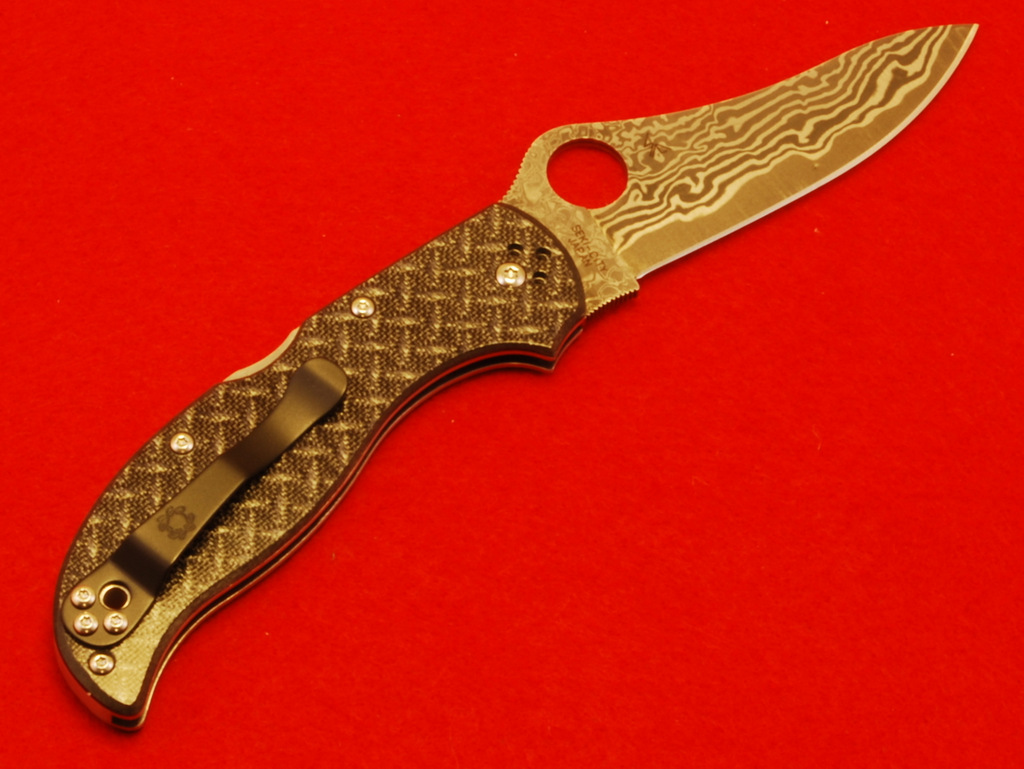Damascus steel users
Damascus steel users
For those who use damascus steel as edc if there are any.How does it perform ? Are there any special issues ? Is it prone to rust ? Or stain...How does it slice ? I am commited to start edc-ing a Stretch damascus in black glass fiber handle so I wonder how does it perform in real life.
- The Deacon
- Member
- Posts: 25717
- Joined: Fri Sep 24, 2004 10:33 am
- Location: Upstate SC, USA
- Contact:
I've only had my damascus Stretch for a few days and only carried it a couple times, so I can't say for certain. However, since it uses VG-10 core damascus, it should cut and hold an edge pretty much exactly the same as a plain VG-10 Stretch, or any other VG-10 blade. As for rust/stain resistance, if it the Stretch uses the same VG-10 core damascus as the SETO kitchen knives, then it won't stain or rust easily. It also has a fairly dark etch, which should reduce the chances of it developing a patina type discoloration.
[CENTER] [/CENTER]
[/CENTER]
[CENTER]
 [/CENTER]
[/CENTER]Paul
My Personal Website ---- Beginners Guide to Spyderco Collecting ---- Spydiewiki
Deplorable :p
WTC # 1458 - 1504 - 1508 - Never Forget, Never Forgive!
My Personal Website ---- Beginners Guide to Spyderco Collecting ---- Spydiewiki
Deplorable :p
WTC # 1458 - 1504 - 1508 - Never Forget, Never Forgive!
There are lots of different forms of Damascus steel. Some are stainless and some are not. Some use a stainless core with a nickel/steel cladding and are stainless. I have the Mcusta Take and it is stainless, according to the company in Japan. It has a VG10 core with overlays of a stainless composite. If a Damascus steel is made from layers of plain carbon steels, it won't be stainless.
Spydercos should be stainless, but you can always email them to be certain about the composition of the layers.
Spydercos should be stainless, but you can always email them to be certain about the composition of the layers.
- phillipsted
- Member
- Posts: 3674
- Joined: Tue Oct 05, 2010 11:30 am
- Location: North Virginia
I have used some high carbon damascus from folks like Alabama Damascus, and these rust if you look at them cross-eyed. That's why the billets and blanks generally come from the shop with a heavy coat of lacquer. If you are working on pre-ground blanks, you can leave the lacquer on the main part of the blade - but as soon as you sharpen the edge bevel, it starts to get a patina and rust. You'll also want to clean the tang well before you put scales on them to ensure that no moisture gets trapped underneath the epoxy.
Some Scandi blades I've purchased from European smiths are made with stainless damascus (generally Damasteel). This ups the corrosion resistance quite a bit. However, stainless damascus can be a bear to heat treat from what I understand - limiting the combinations of steel you can use effectively...
TedP
Some Scandi blades I've purchased from European smiths are made with stainless damascus (generally Damasteel). This ups the corrosion resistance quite a bit. However, stainless damascus can be a bear to heat treat from what I understand - limiting the combinations of steel you can use effectively...
TedP
- The Mastiff
- Member
- Posts: 5951
- Joined: Sun Jun 04, 2006 2:53 am
- Location: raleigh nc
Ted, those Alabama Damascus blades do rust. They are 5160, 52100, plus some nickel containing steel. They do sharpen easy though.
Joe
Joe
"A Mastiff is to a dog what a Lion is to a housecat. He stands alone and all others sink before him. His courage does not exceed temper and generosity, and in attachment he equals the kindest of his race" Cynographia Britannic 1800
"Unless you're the lead dog the view is pretty much gonna stay the same!"
"Unless you're the lead dog the view is pretty much gonna stay the same!"
Stainless steels should properly be called stain resistant steels. All steels oxidize to a greater or lesser degree with carbon steels being more known for the oxides that we all see as rust. Even stain resistant steels can oxidize. Because pattern welded steels are subject to an acid etching, there is the possibility of a surface area increase that allows the material to oxidize at a higher rate than a polished flat or burnished surface. It's simply a risk taken for the material produced.
Stain resistant steels can benefit from passivation, also an acid treatment, that essentially increases oxidation protection. So the advantage for a VG10 composite that has been etched is that it should resist oxidation more than a blade not etched.
Either way, enjoy the blade and if your confidence says this blade will be easy to care for and not rust, you may be surprised.
Stain resistant steels can benefit from passivation, also an acid treatment, that essentially increases oxidation protection. So the advantage for a VG10 composite that has been etched is that it should resist oxidation more than a blade not etched.
Either way, enjoy the blade and if your confidence says this blade will be easy to care for and not rust, you may be surprised.